Today we look at some high-end P55 motherboards from three different manufacturres in order to see just how well they perform against each other using the all-new Intel i7 K875 processor. We will be looking at price, performance, features, and build quality.
Today’s three contenders are the ASUS Maximus lll Extreme rev 1.01G, Gigabyte GA-P55A UD6 rev1.0, and EVGA's FTW 200 E658 Rev 1.0 with each motherboard having been flashed with the latest revision BIOS available at time of testing.
There are four main categories that we will use; out of the box complete stock settings, a x31 multiplier applied on the CPU leaving everything else at stock settings, a 4.2GHz overclock on the CPU running quad channel memory CAS 6 and a 4.2Ghz overclock on the CPU with 2400MHz dual channel memory at CAS 9.
The aim of running these tests are to see how well the motherboards perform under normal conditions and overclocked with different settings, most users either stick with air or water cooling for their CPU, so we will be using a standard Zalman water cooling unit for our tests.
Each of the categories comprises of at least ten tests. There is also a maximum CPU-Z, some maximum Super Pi 32m times using both dual and quad channel memory and a maximum dual memory speed each board could achieve.
There will be a point scoring system with the winner of each round awarded 3 points for first place, 2 points for second place and 1 point for third place. If any of the motherboards are unable to complete a test/tests then 0 points will be awarded. Please note that we will not be basing our conclusion solely on these facts.
Test System
Intel Core i7 K875 (LGA1156)
CPU Cooling: Water
4 X Patriot PC3 - 19200 2400MHz Memory
Asus Maximus lll Extreme
EVGA P55 FTW E658
Gigabyte P55-UD6
Corsair (950 watt)
Intel 3Gb/s SATA SSD 64G
ATI Radion HD 4890
Microsoft Windows 7 Ultimate (64-bit)
Bench-test's
3Dmark Vantage
3Dmark06
CineBench
WinRar
Pifast
Super Pi32M
Wprime
Hyper Pi
OCCT LINPACK
Stock Power consumption
Each of the Bench-test's has run three times with the middle score used for validation.
However, before we begin let's take a brief look at each of the contenders.
ASUS Maximus III Extreme
ASUS added a new P55 motherboard to their line-up back in February 2010 called the Maximus III Extreme. The all-new Intel LGA 1156 motherboard supports Core i3/i5/i7; the board supports up to 16GB of DDR3 memory has five PCI-E x16 slots, SATA 6Gbps, USB 3.0 and even has Bluetooth support via a plug in card.
The colour scheme used is black and red just like its older brother the ASUS Maximus III Formula
Looking at the socket reveals 8+3 phase PWM using Fujitsu FPCAP. The DIMM slots have a 3 phase PWM.
You can see multi-meter probe points at the side edge of the board, there are five positions where you can measure voltage. The voltage measurement points are available in an easy to use location and include checkpoints for the CPU pll volts, PCH volts, the CPU Vcore, Dram and the IMC volts, you will also notice Below the 24 pin power connector is some LEDs showing a 4 status POST process of the motherboard.
The memory retention method pushes straight down rather than rotating into place via a locking mechanism, which makes changing GFX cards a breeze.
In the middle of the motherboard lays the NF200 above the top PCI-E slot underneath the ROG heatsink.
Asus has opted for a Marvell SATA 6Gbps controller to provide the two red SATA6 ports with the P55 PCH providing the 6 grey SATA 3Gbps connectors and another SATA 3Gbps connector provided by a Marvell controller that also supplies the eSATA port.
Below the PCH heatsink are two socketed BIOS chips with the red button in the corner switching the active BIOS chip.
There are no less than 8 x 4 pin Fan connectors on the motherboard
1 x CPU / 1 x PWR / 3 x Chassis / 3 x Optional which can all be controlled via ASUS's software making for smooth quite running if needed.
The PCI-E slots are arranged to run 4-way Crossfire with double-width cards. The board also supports 3-way SLI with PhysX. Near the first PCIe slot is a Molex connector to provide additional PCI-E power for multi-GPU configurations. There is also another Molex connector at the edge of the board near the Power and Reset buttons.
The Rear I/O has 8 USB 2.0 ports, a FireWire 800 port, two USB 3.0 ports, a PS/2 keyboard port, 6 audio jacks, a Gigabit Ethernet port, and a jack for a Bluetooth module. ROG Connect port, which is the USB 2.0 port next to the audio jacks. When the link button is pressed, the port is used by ROG Connect to synchronize up the board to another computer.
Specifications
CPU
Intel® Socket 1156 Core™ i7 Processor/Core™ i5 Processor/Core™ i3 Processor
Supports Intel® Turbo Boost Technology
Chipset
Intel® P55 Express Chipset
Memory
4 x DIMM, Max. 16 GB, DDR3 2200(O.C.)/2133(O.C.)/2000(O.C.)/1800(O.C.)/1600/1333/1066 Non-ECC, Un-buffered Memory
Dual Channel memory architecture
* Hyper DIMM support is subject to the physical characteristics of individual CPUs.
* Supports Intel® Extreme Memory Profile (XMP)
* Please refer to www.asus.com or user manual for the Memory QVL (Qualified Vendors List).
Expansion Slots
5 x PCI-E 2.0 x16 Supports single at x16, dual at x16, triple at x 16 x16 x8, quad x8, or 5 x8
1 x PCI 2.2 Multi-GPU Support Supports NVIDIA® SLI™ Technology / ATI® CrossFireX™ Technology
Storage
Intel® P55 Express Chipset built-in 6 x SATA 3.0 Gb/s ports (Gray)
Intel Matrix Storage Technology Support RAID 0,1,5,10
JMicron® 363 controllers:
1 x SATA 3.0 Gb/s port (Black)
1 x External SATA 3.0 Gb/s port (SATA On-the-Go)
Marvell® PCI-E SATA 6Gb/s controller
2 x SATA 6.0 Gb/s ports (Red) LAN Realtek® RTL8112L Gigabit LAN controller
Audio
VIA® VT2020 10-Channel High Definition Audio CODEC
Supports Blue-ray audio layer content protection
Supports 1 Optical S/PDIF out port at back I/O
Supports 1 S/PDIF out header
Supports Jack-detection, Multi-streaming, Front Panel Jack-retasking
IEEE 1394
2 x 1394a port(s) (1 port onboard, 1 port at back I/O)
USB
NEC® USB 3.0 controller
2 x USB 3.0/2.0 ports (at back I/O)
Intel® P55 Express Chipset
11 USB 2.0 ports (4 ports at mid-board, 7 ports at back I/O, 1 port at back I/O is also for ROG connect)
Overclocking Features
ROG Connect
RC Bluetooth
Extreme Engine Digi+
8-phase CPU digital VRM power
3-phase VTT digital VRM power
3-phase Memory power
ML Cap for CPU
ProbeIt
iROG
Extreme Tweaker
BIOS Flashback
Loadline Calibration
Intelligent overclocking tools:
8 O.C. Profile
Overclocking Protection:
COP EX (Component Overheat Protection - EX)
Voltiminder LED
ASUS C.P.R. (CPU Parameter Recall)
Special Features
CPU Level Up
MemOK!
Onboard Button: Power / Reset / Clr CMOS (at back IO)
ASUS MyLogo3
ASUS Fan Xpert
ASUS EZ Flash 2
ASUS CrashFree BIOS 3
ASUS Q-Connector
ASUS Q-LED (CPU, DRAM, VGA, Boot Device LED)
ASUS Q-Slot
ASUS Q-DIMM
Back Panel I/O Ports
1 x External SATA
1 x IEEE 1394a
1 x LAN(RJ45) port
10 -Channel Audio I/O
1 x Clr CMOS switch
1 x PS/2 Keyboard port (purple)
2 x USB 3.0/2.0 ports
7 x USB 2.0 ports (1 port also for ROG Connect)
1 x ROG Connect On/Off switch
S/PDIF Out (Optical)
Internal I/O Connectors
2 x USB connectors support additional 4 USB 2.0 ports
9 x SATA connectors: 2 x SATA 6.0Gb/s connectors (Red) / 6 x standard SATA connectors (Black) / 1 x SATA_E(Gray)
8 x Fan connectors: 1 x CPU / 1 x PWR / 3 x Chassis / 3 x Optional
5 x ProbeIt Measurement Points
3 x Thermal Sensor Connectors
1 x IEEE1394a Connector
1 x SPDIF_Out Connector
1 x 24-pin ATX Power Connector
1 x 8-pin ATX 12V Power Connector
1 x En/Dis-able Clr CMOS Switch
1 x LN2 Mode Header
1 x Power on Switch
1 x Reset Switch
2 x EZ Plug Connectors
1 x OC Station Header
1 x RC Bluetooth Header
1 x Go Button
1 x BIOS Button
System Panel Connector
BIOS
16 Mb Flash ROM AMI BIOS, PnP, DMI2.0, WfM2.0, SM BIOS 2.5, ACPI2.0a Multi-Language BIOS
Manageability
WOL by PME,WOR by PME,PXE Accessories 1 x RC Bluetooth Card
1 x I/O Shield
1 x Optional Fan
1 x ROG Connect Cable
1 x SLI Cable
1 x 3-way SLI Cable
1 x 2-in-1 ASUS Q-Connector Kit
1 x 2-in-1 SATA 6.0Gb/s Cables
3 x 2-in-1 SATA 3.0Gb/s Signal Cables
1 x 2-port USB2.0 + ESATA Module
1 x Thermal Sensor Cables Pack
1 x Cable Ties Pack
1 x ROG Theme Label
1 x 12-in-1 ROG Cable Label
1 x User's Manual
Bluetooth Module Accessory Card
Bluetooth V2.0/V2.1+EDR
RC Bluetooth On/Off Switch
Support Disc
ASUS PC Probe II
ASUS AI Suite
ASUS Update
Kaspersky® Anti-Virus
Support DVD:
Drivers and Applications
Futuremark® 3DMark® Vantage Advanced Edition
ASUS TurboV EVO Utility
Form Factor
ATX Form Factor
12 inch x 9.6 inch ( 30.5 cm x 24.4 cm )
The BIOS is laid out nicely and is very slick, this means the user has an easier time getting the most from the motherboard.
Click to see slide show
Gigabyte GA-P55A-UD6
The Gigabyte GA-P55A-UD6, is a special revision of the original P55-UD6 motherboard that adds next generation features. The A in GA-P55A-UD6 means that the motherboard is part of Gigabyte's new "333" series of motherboards. The GA-P55A-UD6 has three new improvements in the form of SATA 6.0 GB/s using a Marvell SE9128 controller for faster hard drive transfers, enhanced USB voltage capabilities, and USB 3.0 support for high-speed peripherals thanks to a NEC µPD720200controller.
The staggering number of features included and the solid heatsinks used also contribute to the overall weight of this motherboard, making it quite weighty.
The presence of six DIMM slots when the P55 chipset only calls for four was quite a surprise for us. With a dual-channel memory controller on the Lynnfield CPU, we were not expecting more than the usual four like all other P55 motherboards we have seen. If all six slots are populated, the ones in blue slots can only accept single-sided memory modules, which are not as dense as double-sided modules.
Expansion the first slot is the PCI-E 1x slot, Second slot is PCI-E 16x unless you are using SATA 3 or USB 3.0 Turbo then it drops to 8x. Third slot is another PCI-E 1x which will be obstructed by a dual slot cooler GPU. Then a regular PCI slot followed by another PCI-E 16x slot that will run at 8x during multi-GPU operation. Again, if you enable SATA 3 or USB 3.0 Turbo you cannot use Multi-GPU so this slot would have to remain unused. If you disable USB 3.0 Turbo and SATA 3 Turbo and run Multi-GPU's the first two PCI-E 16x slots run at 8x8x. That is a limitation of the Intel P55 chipset. Geek Gods forbid that Intel would give us two PCI-E 16x slots running full speed without buying into the LGA 1366 i7 platform. After the second PCI-E slot, you get another PCI slot then finally the third PCI-E 16x slot.
The motherboard still has Support for both IDE and FDD. Why we ask this is 2010 where everyone is using SATA and USB these days.
On-board debug LED, makes it easy to diagnose boot-up errors.
There are no less than 6 x Fan connectors on the motherboard
1 x 4Pin CPU / 1 x 3pin PCH / 3 x 3pin Chassis / 1 x 4pin Chassis While there seems to be enough fan headers here, it is a disappointment that they could not all be controlled though.
The P55A-UD6 has an extremely busy I/O panel that features virtually every connection you could possibly need. There is a single PS/2 connector supporting either a keyboard or mouse, 6 USB 1.1/2.0 /3.0 ports, 2 Firewire ports, 2 eSATA /USB ports, 2 LAN ports, 6 audio jacks and a S/PDIF and Coaxial connector.
CPU
Support for an Intel Core i7 series processor/Intel Core i5 series processor in the LGA1156 package (Go to Gigabyte's website for the latest CPU support list.) L3 cache varies with CPU
Chipset
Intel P55 Express Chipset
[BMemory [/B]
6 x 1.5V DDR3 DIMM sockets supporting up to 16 GB of system memory
Dual channel memory architecture
Support for DDR3 2600+/2200/1333/1066/800 MHz memory modules
Support for non-ECC memory modules
Support for Extreme Memory Profile (XMP) memory modules
Audio
Realtek ALC889A codec
High Definition Audio
2/4/5.1/7.1-channel
Support for Dolby Home Theater
Support for S/PDIF In/Out
Support for CD In
LAN
2 x RTL8111D chips (10/100/1000 Mbit)
Support for Teaming
Support for Smart Dual LAN
Expansion Slots
1 x PCI Express x16 slot, running at x16 (PCIEX16_1)
1 x PCI Express x16 slot, running at x8 (PCIEX8_1) (The PCIEX16_1 and PCIEX8_1 slots conform to PCI Express 2.0 standard.)
1 x PCI Express x16 slot, running at x4 (PCIEX4_1)
2 x PCI Express x1 slots
2 x PCI slots
Multi-Graphics Technology
Support for ATI CrossFireX/NVIDIA SLI technology (PCIEX16_1 and PCIEX8_1 slots only.)
Storage Interface
6 x SATA 3Gb/s connectors (SATA2_0, SATA2_1, SATA2_2, SATA2_3, SATA2_4, SATA2_5) supporting up to 6 SATA 3Gb/s devices
Support for SATA RAID 0, RAID 1, RAID 5, and RAID 10
Marvell 9128 chip:
2 x SATA 6Gb/s connectors (GSATA3_6, GSATA3_7) supporting up to SATA 6Gb/s devices
Support for SATA RAID 0
JMB362 chip:
2 x eSATA 3Gb/s connectors (eSATA/USB Combo) on the back panel sup- porting up to 2 SATA 3Gb/s devices
Support for SATA RAID 0, RAID 1 and JBOD iTE IT8213 chip:
1 x IDE connector supporting ATA-133/100/66/33 and up to 2 IDE devices iTE IT8720 chip:
1 x floppy disk drive connector supporting up to 1 floppy disk drive
[B]USB [B]
Up to 12 USB 2.0/1.1 ports (8 on the back panel, including 2 eSATA/USB Combo, 4 via the USB brackets connected to the internal USB headers)
NEC chip
Up to 2 USB 3.0/2.0 ports on the back panel
[B]IEEE 1394 [B]
Texas Instruments TSB43AB23 chip
Up to 3 IEEE 1394a ports (2 on the back panel, 1 via the IEEE 1394a bracket connected to the internal IEEE 1394a header)
TPM Security
Infineon SLB 9635 TT 1.2 chip
Internal I/O Connectors
• 1 x 24-pin ATX main power connector
• 1 x 8-pin ATX 12V power connector
• 1 x floppy disk drive connector
• 1 x IDE connector
• 6 x SATA 3Gb/s connectors
• 2 x SATA 6Gb/s connectors
• 1 x CPU fan header
• 3 x system fan headers
• 1 x power fan header
• 1 x Chipset fan header
• 1 x front panel header
• 1 x front panel audio header
• 1 x CD In connector
• 1 x S/PDIF In header
• 1 x S/PDIF Out header
• 2 x USB 2.0/1.1 headers
• 1 x IEEE 1394a header
• 1 x serial port header
• 1 x clearing CMOS button
• 1 x power button
• 1 x reset button
Back Panel Connectors
• 1 x PS/2 keyboard/mouse port
• 1 x coaxial S/PDIF Out connector
• 1 x optical S/PDIF Out connector
• 2 x IEEE 1394a ports
• 6 x USB 2.0/1.1 ports
• 6 x USB 3.0/2.0 ports
• 2 x eSATA/USB Combo connectors
• 2 x RJ-45 ports
• 6 x audio jacks (Center/Subwoofer Speaker Out/Rear Speaker Out/ Side Speaker Out/Line In/Line Out/Microphone)
I/O Controller
iTE IT8720 chip
H/W Monitoring
System voltage detection
CPU/System temperature detection
CPU/System/Power fan speed detection
CPU overheating warning
CPU/System/Power fan fail warning
CPU/System fan speed control
BIOS
2 x 16 Mbit flash
Use of licensed AWARD BIOS
Support for Dual BIOS
PnP 1.0a, DMI 2.0, SM BIOS 2.4, ACPI 1.0b
Unique Features
Support for @BIOS
Support for Q-Flash
Support for Xpress BIOS Rescue
Support for Download Center
Support for Xpress Install
Support for Xpress Recovery2
Support for Easy Tune
Support for Dynamic Energy Saver 2
Support Smart TPM
Support for Smart 6
Support for Q-Share
Bundle Software
Norton Internet Security (OEM version)
Operating System
Support for Microsoft Windows 7/Vista/XP
Form Factor
ATX Form Factor; 30.5cm x 24.4cm
The BIOS is laid out quite well but needs a little work.
Click to see slide show.
EVGA P55 FTW200 E658
The FTW200 E658 is a dark and aggressive looking motherboard. EVGA has gone with the black-gray theme with almost all their P55 motherboards in its line up that is all but the FTW 200 Classified. While the board looks quite imposing, it does so without being covered in a maze of massive heatsink like the ones we have grown to see become more common these days.
EVGA has thought outside of the box by including support for both LGA1156 and LGA775 coolers with the P55 FTW200. Rather than include a single set of mounting holes EVGA has also accommodated for the older LGA775 heatsinks. Each set is clearly labelled either LGA1156 or LGA775 on the board itself to avoid confusion.
There is a pair of very large black aluminium heatsinks at the top left side which are designed to receive airflow from the CPU cooler, this in turn cools the board’s 12 + 2 power phase with 2x8pin CPU connectors that can provide up to 600w of power for the CPU
The P55 chip is cooled by a small black heatsink located directly to the side of the SATA ports.
Another feature that hits at the hardcore soul of the EVGA P55 FTW200 are the voltages read points at the top right of the board, which allow users to attach a multi-meter to read various system voltages. EVGA has also gone with LIC Capacitors (low inductance chip), another feature meant to help enthusiasts push their CPU to the limit.
The EVGA P55 FTW200 provides three PCI-E x16 slots and one PCI-E x8 slot, though using three of these with either Crossfire or SLI technology will reduce its bandwidth to x8 each. The P55 FTW200 also comes equipped with a single PCI-E x1 slot and one traditional PCI slots
Common DIMM slot/PCI-E x16 connector conflict is not present with the FTW200 and we found installing/removing memory on this motherboard to be a breeze with a large graphics card installed.
The 24-pin ATX power connector is located in the middle right hand side of the motherboard where it is easy to access; the eight onboard SATA ports have been mounted on a 90-degree angle to avoid any conflicts with long graphics cards. The CMOS battery is located between the PCI-E x16 slots making it difficult to access, but with the addition of a CMOS reset button on the I/O panel we can let this slide.
Bios Switch 1,2,3, Reset, power, Ccmos Buttons.
De-bug LCD poster next to the USB
There are 7 x Fan connectors on the motherboard
1 x 4Pin CPU / 1 x 3pin JCHA / 3 x 3pin Chassis / 1 x 3pin JPWR / 1 x 3pin JAUX
The ECP V2 provides users with several useful functions at their convenience with a click of a button.
On the I/O panel, we have a PS/2 keyboard port, six audio jacks, dual eSATA, A CMOS clear button, dual LAN ports, and six USB 2.0 ports. With a further six USB 2.0 ports featured on-board we would have liked to see more make their way into the I/O panel. However, sadly to say no optical and S/PDIF ports but there is the edition of EVGA's EVbot Support a Handheld-overclocking device that interfaces directly to the BIOS while your system is booted in OS
EVGA P55 FTW200 LGA1156 ATX Extreme
3-Way SLI Enthusiast Motherboard
PCI-E 16X/8X (3)
PCI-E 4X (1)
PCI-E 1X (1)
PCI (1)
Supports Dual Channel DDR3 Memory Max 4 Slots up to 16GB, 1.65V 240Pin
SATA (6)
PATA (0)
ESATA (2)
Gigabit Ethernet Port (2)
USB Ports (6R/6O)
1394a (1R/1O)
8 Channel High Definition
Black/Grey PCB
3 Year Warranty
Supports Intel Core i5/i7 LGA1156
ATX Form Factor
Length: 12in - 304.8mm
Width: 9.6in - 243.84mm
The BIOS has it all but can be a bit complicated for the beginner
Click to see slide show
We began our tests with out of the box Stock settings leaving the Motherboard's to set their required voltages and timings ECT. On running the tests, we were amassed at first just how well the Gigabyte board was doing in the bench-tests. (This was until we noticed that by default Gigabyte had chosen to set a stock base clock off 136.7 Bclock) This is out of spec and overclocked according to Intel's own specifications.
The other two motherboards in our round-up were running the base Clock frequencies of 133 Bclock as set by Intel specification, so decided to make things fair we had to down clock the Gigabyte board as this would only then show its true performance in the following tests.
The first 3D test goes to the ASUS M3E, with an advantage of 199 Points over the E658 and 242 points clear of the UD6.
The M3E does it again in the second 3D test, as we know there can be some dicpreencies between runs in these sort of sinthetic benchtests, but neatherless taking the midel results of each board clearly shows the ASUS has the edge over its competitors at stock speed's so far.
Moving on to an intensive single and multi thread benchmarks using Cinebench shows the ASUS has a slight lead over its competitors.
The same is true again, the Wprime 32M and 1024M tests shows the ASUS to be the most efficient in this multi thread test at stock settings.
Moving swiftly onto WinRar, Super pi 32M and PiFast shows us that the ASUS board calculates and process a little more data than the than the rest.
On power consumtion, we measuerd total system watts at the wall of a complet system setup.
Eleven tests and price comparision carried out, the ASUS M3E becomes a clear winner for stock out of the box performance in our tests, both the EVGA and Gigabyte scoreing a sold second place. It is far to early to call yet so hold tight for our next round.
X31 multiplier applied to the fully unlocked 875KCPU with all other settings left at Stock in these tests.
How well will the boards deal with the extra load and sudden changes in frequency imposed on them. The boards will be in an idle state of 1200MHz then going up to 4123 MHz loaded.
The ASUS was by far the easiest to use as simply dialling in a 31 multiplier was all it needed, the EVGA needed to have Speed-step enabled and for the Gigabyte Turbo boost needed to be disabled as it applied a higher multiplier than we had set.
The M3E just tips EVGA's E658 with the Gigabyte someway behind in 3DVantage, 3Dmark 06 is around the same but with the gap becoming a lot closer between the ASUS and EVGA motherboards.
The Cinebench tests show ASUS winning both rounds, but for some reasion we have mixed results between Gigabyte and the EVGA boards in these two tests, looks like the EVGA does a better job in multi thread.
These Wprime test's are very close,but neatherless the ASUS wins again.
Some mixed results shown here with the ASUS winning Winrar, but just tipping the scales in faver of the Gigabyte board is PiFast and Super pi 32M just ahead of the M3E with the EVGA board.
The ASUS is still out in front, but things are starting to tighten up a little now.
Moving onto a 4.2GHz overclock with the Intel K875-CPU and 1600MHz CAS 6 for our memory running quad channel, how well will the boards cope with matched memory Timings and voltages.
The Gigabyte is clearly showing some advantage over the other motherboards in both the 3D benchmarks.
M3E regains again in Cinebench with the UD6 close on its tail
Wprime goes to the M3E, the EVGA E658 just ahead of the Gigabyte UD6.
The EVGA E658 is starting to come alive now winning both the WinRar and Super Pi 32M round, though ASUS took the PiFast benchtest
We now wanted to see if the boards where stable at the given speeds and configerations so decided to run Hyper Pi 32mm, all the boards passed this test with the EVGA E658 just piping the outher two boards.
Things have started to closen up now with only a two points advantage over the outher two boards.
Keeping with the 4.2GHz overclock on the Intel K875CPU we removed two sticks of memory and decided on running Dual channel 2400MHz CAS 9. Would the Extra bandwidth show any flaws in our manufactures boards?
The EVGA E658 is now starting to show its true colours in both of the 3D bench tests
The ASUS M3E not being happy about losing its place in the 3D Benchtests it strikes back to the top with avengenc in the Cinebench tests.
Wprime goes to the ASUS again but just under two seconds is now covering our three boards in 1024M
The M3E has taken top place in all three of these benchtests, but only by miliseconds in two of them.
Again testing for stability we ran Hyper pi 32M, surprising enough all boards passed this test but at this memory frequency it was more about the CPU's IMC rather than the board.
However, the Gigabyte just takes the lead with a hairline advantage.
We looked to see if the motherboards function how they should, testing sleep mode, speed-step, turbo boost, plus the given software that came with each board.
We were quite impressed to find most things worked, but were disappointed in not being able to use our Iphone to overclock the ASUS M3E, but told via ASUS HQ this would be available very soon.
Not being a great believer in XMP profiles as this manly comes down to how good the CPU's IMC is. We decided to test as it is implemented in all the Motherboards BIOS's we had.
All of the above motherboards booted with sensible voltages using our Dual channel memory kit at 2400Mhz CAS 9 but sadly only the ASUS and EVGA managed to pass Hyper pi 32m, with the Gigabyte UD6 failing on loop 7.
Neither of the boards could even boot with Quad memory at 2400MHz let alone run Hyper pi, which goes back to what we said about XMP profiles.
Maximum Super pi 32m
All boards completed this test with a staggering overclock of 4.7 GHz or just above, which is not too bad considering we were only using a cheap water cooling solution to cool or CPU
Both the EVGA E658 and ASUS M3E proved to have around the same speed at their given clocks where the Gigabyte was slightly slower even with a few more MHZ up its sleeve
Maximum duel memory speed
Now pushing to see what Motherboard could get the most from the Dual channel memory we found the ASUS just tipping the scales reaching a blistering 2503.8MHz, with the other two motherboards topping out around 2459.8 for the EVGA and 2459.2 MHz for the gigabyte
Maximum Quad memory speed
With four Dimms in place both the ASUS and gigabyte board managed to hit 2220Mhz, unfortunately the EVGA had some issues running at these speeds no matter what we tried nothing would get the board to complete supper pi past2100Mhz, and sadly for us even corrupted our hard drive with the saved screen shoot.
Maximum CPU-Z
Going all out now for some MHz, now we had finished with all our tests we thought we would have a little fun to see just how far we could push the Intel 875K CPU on our water setup, which to be honest is nothing special.
Keeping the Vcore around 1.5v we began pushing the Bclock using the Manufactures own overclocking software that came with the motherboards.
Things were very close here and more to do with the cooling we had to hand, but however the EVGA E658 just edges it out with a staging 4937.5 MHz overclock
http://valid.canardpc.com/show_oc.php?id=1318442
http://valid.canardpc.com/show_oc.php?id=1310552
http://valid.canardpc.com/show_oc.php?id=1313497
We just wanted to recheck to see if our CPU, memory, and boards were still in perfect working order, to check this we ran OCCT LINPAC for one hour with sleep mode enabled after 30Minutes, then left this for one hour to see if the keyboard would bring the systems out of sleep to continue the test.
Happy for us everything was still working fine with is a testament to the motherboards, memory, and most of all the Intel 875K CPU, which had done some stressful work for many hours.
Conclusion
As the results in this review have shown picking the best P55 is a challenging task, the three products tested all offer similar performance in all the tests we did so making it very hard to separate the three motherboards. Yes, if we look at the point scoring system then yes, the ASUS M3E wins, but if we look closer at the all the results they are very close, therefore we have to look deeper into each of the products when deciding which is best.
The Gigabyte GA- P55A-UD6 is certainly the most cost-effective coming in at £185. In addition, the build quality is not to bad but not the best we have seen, USB 3.0 and SATA 6.0 Gb/s controllers will attract buyers. But unfortunately, those controllers are deactivated in Crossfire or SLI modes, so the board can only be considered either a high-end gaming or a power-user product, not both.
However, pushing the board, we found it a little tricky sometimes and had to clear the Coms to get it to boot, also it was a little unstable when fully loaded at high frequencies and required a few reboots to pass some of the tests. The BIOS is clearly laid out and quite simple to use, Nevertheless, Gigabyte needs to set the motherboard up with a stock 133Bclock rather than being overclocked for its default setting, at the end of the day it is up to the end user if he or she wishes to have an overclocked system. The presence of six DIMM slots on the board when the P55 chipset only calls for four is something Gigabyte needs to look into as well.
Apart from a few things, we found wrong with the UD6, it has good all-round performance, features, and makes the P55A-UD6 a worthy consideration.
The EVGA FTW 200 E658 may not be the cheapest P55 motherboard around coming in at £236, but when we look at what it has offer. 2x8pin CPU connectors that can provide up to 600w of power for the CPU, voltages read points, three way Bios Switch, LIC Capacitors and accommodated for older LGA775 heatsinks, clearly makes this an enthusiasts motherboard for those wish to get every last bit of performance out of there system.
The Dummy OC feature in the BIOS, which can give a significant boost in performance by simply changing one setting, is a nice touch for the novice user.
The board has huge overclocking potential and performance that was not fully explored during our tests due to the type of cooling used, so expect a lot more if you are going colder. The large black aluminium Mosfet coolers look great and work very well in keeping things nice and cool around the CPU area.
The ECP V2 provides users with several useful functions at their convenience with a click of a button. Power, reset, and clear CMOS switches are to hand, and then there are jumpers to enable or disable PCI-E slots and voltage booster buttons as well. The booster buttons allow for 0.1v increases to vcore or VTT by a simple button click, there is also LEDs, which indicate when the voltage boosters are engaged and post process display.
On the downside the BIOS can be quite tricky and needs a bit more input than the other boards we tested, it is mainly aimed at the advanced user to get the most from this motherboard. the lack of SATA 6 and USB3 could be a problem for some users but Both features can be added at a later date with an add-in card, that is if the user wishes, but we feel EVGA should bring this product up to date and start including this with their motherboard.
The Asus Maximus III Extreme is the most expensive P55 motherboard out of the line up, topping in at a hefty £257, but then again we are not talking about an average motherboard, the Maximus III Extreme was a total pleasure to use and if we are honest, it felt just like the EVGA E658 but with a more polished BIOS.
Overclock recovery was a breeze with one loop back to BIOS instead of having to clear the coms and start again; it is by far easier to overclock than its competitors motherboards are and seems to offer that bit more, the fan control is very comprehensive and offers full control to all its headers, something we would like to see on all motherboards these days.
We think ASUS may have gone over the top when it comes to overclocking tools though. The Bluetooth mobile phone overclocking may not appeal to everyone, this could be quite cumbersome and awkward, but not having had the chance to try out we cannot say for sure. There is of course ROG connect, which works great and does just what it was intended for, and the ASUS OC station.
One thing we must point out compared to the motherboards we tested The ASUS M3E felt quit flimsy compared to the EVGA and Gigabyte, and heatsink's on the ASUS motherboard got quite hot and needed to be kept cool with the addition of a fan blowing over them; maybe a larger heatsink was needed.
On whole, we think ASUS did a good job in the Asus Maximus III Extreme, we would have liked to see a second Ethernet connector, and a cheaper price, considering P55 is a mainstream product.
But having said this if money is no object and you're looking for the one of the fastest P55 setups today, that is easy to setup, use and overclock then the Asus Maximus III Extreme would be a good choice.



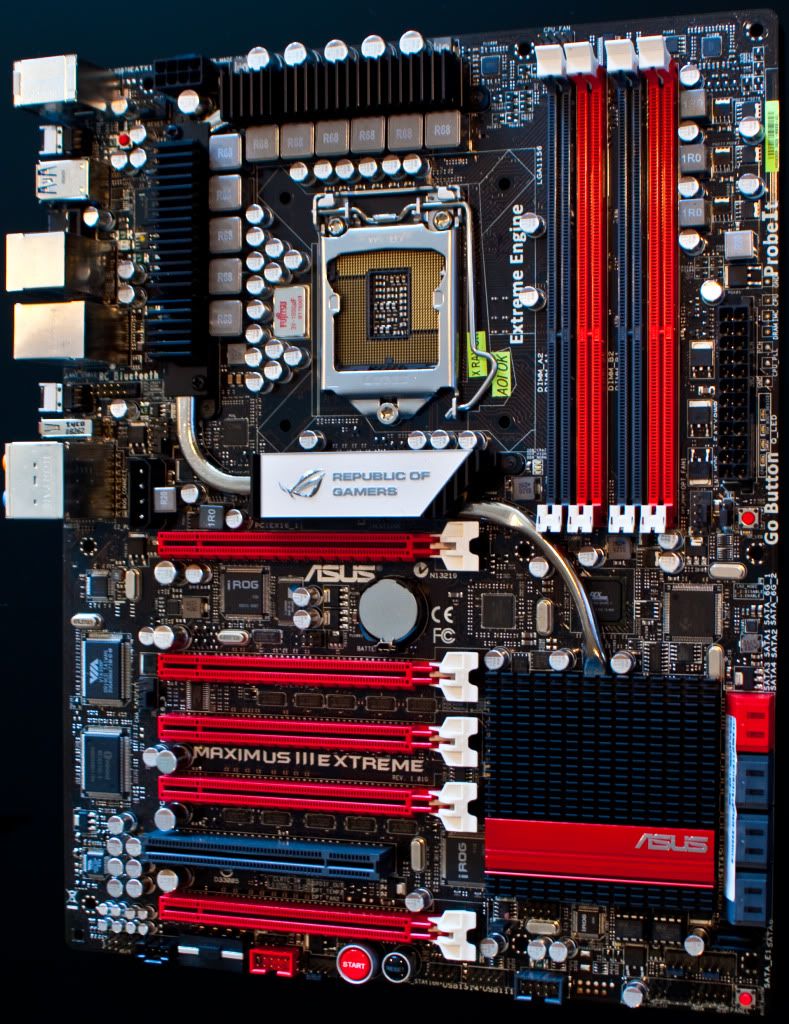
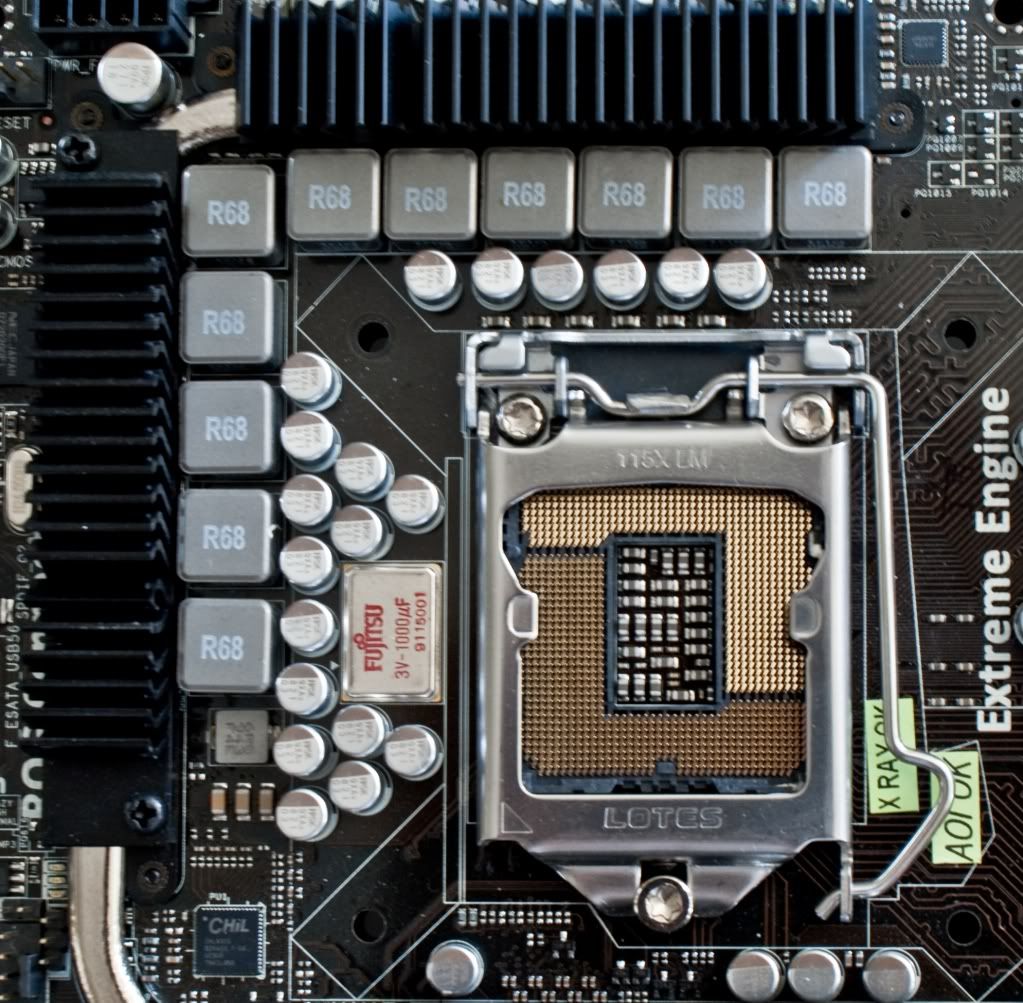

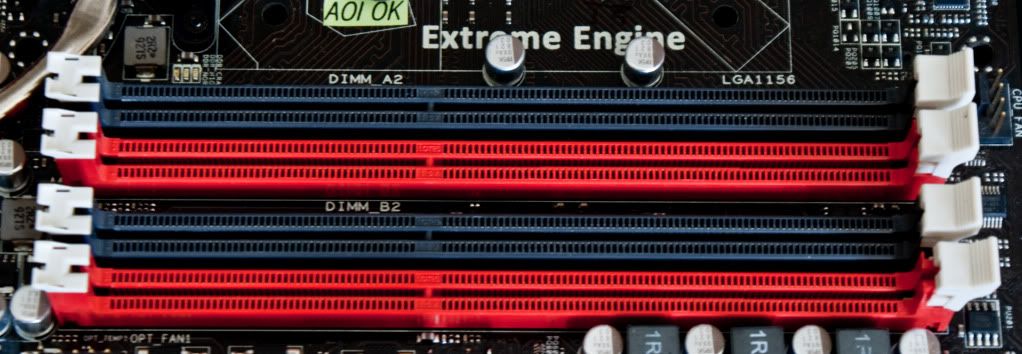

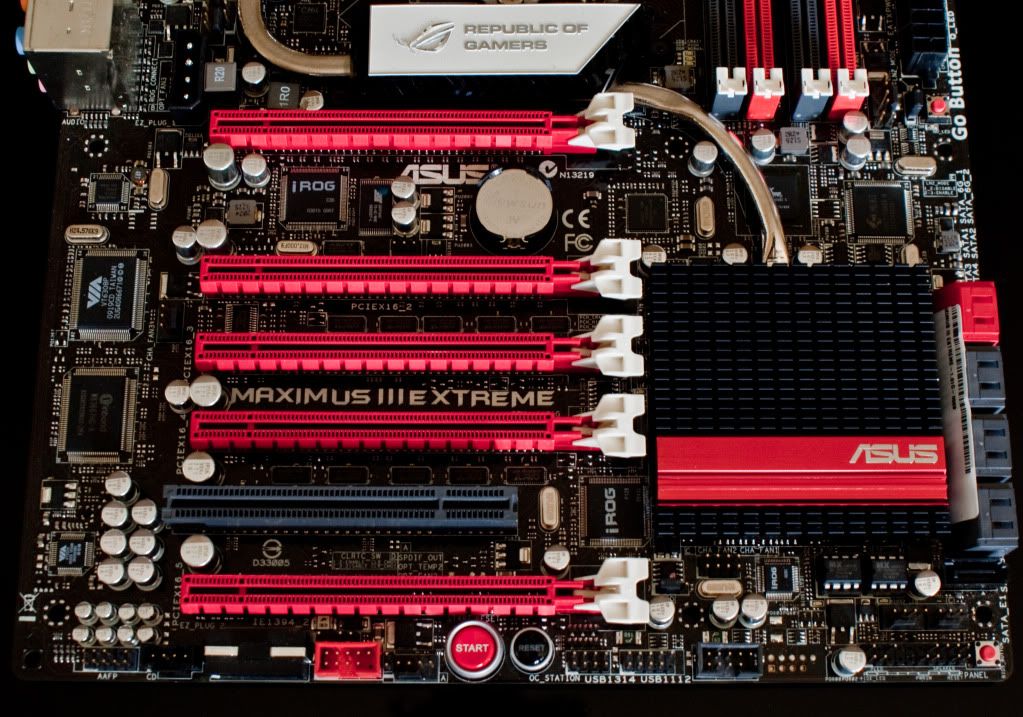
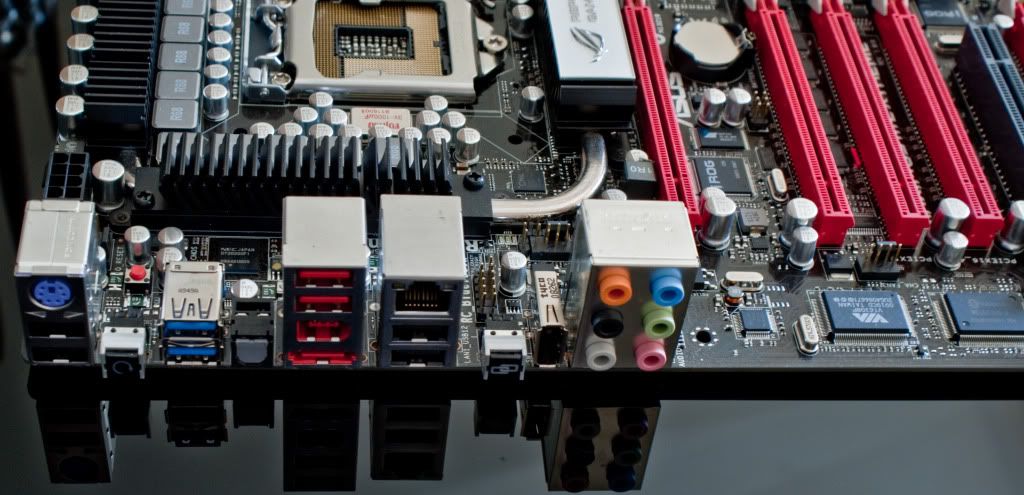
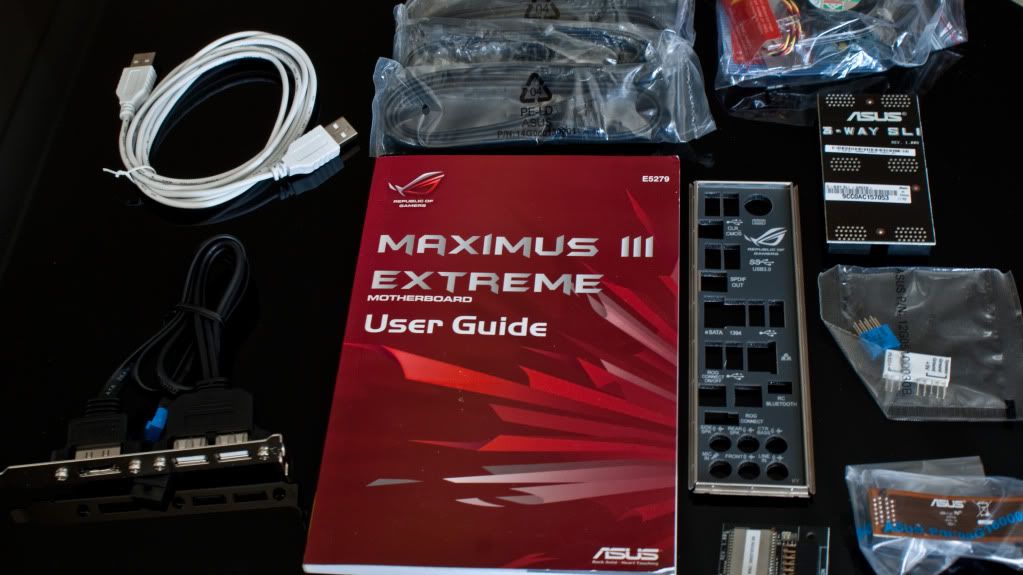

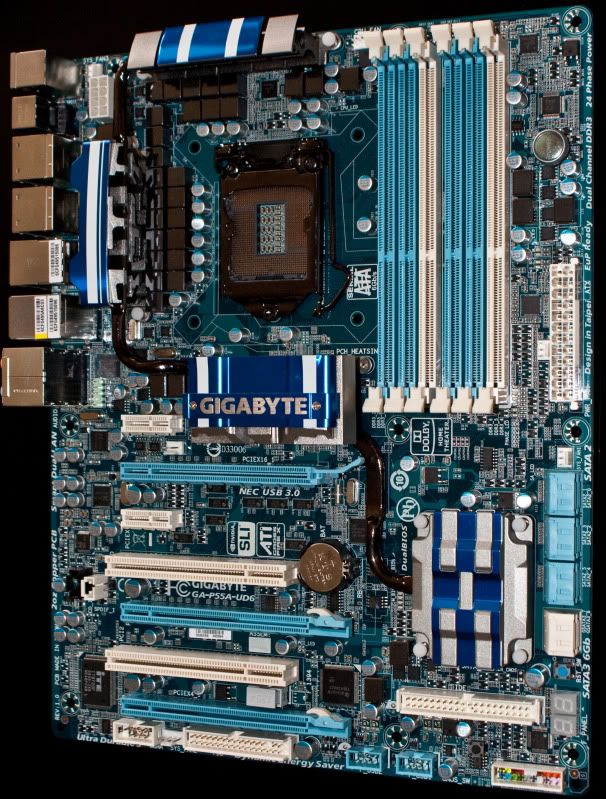
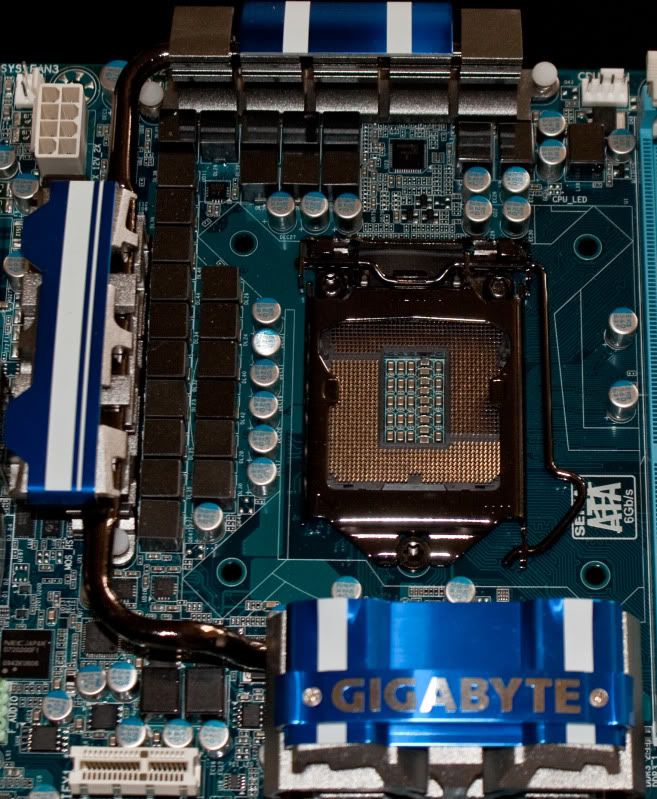
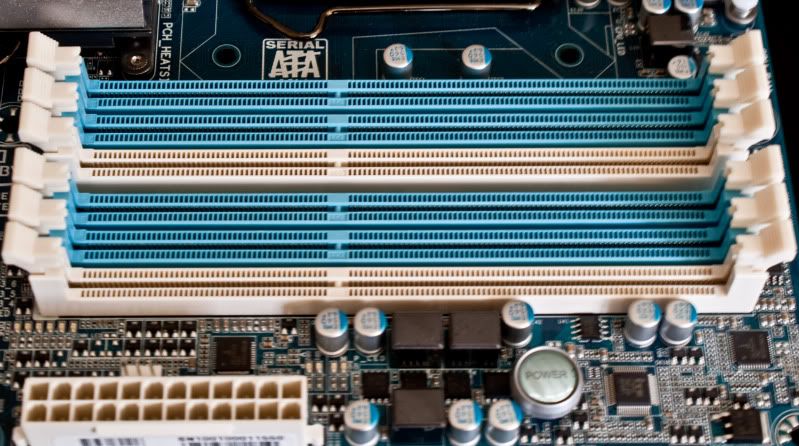
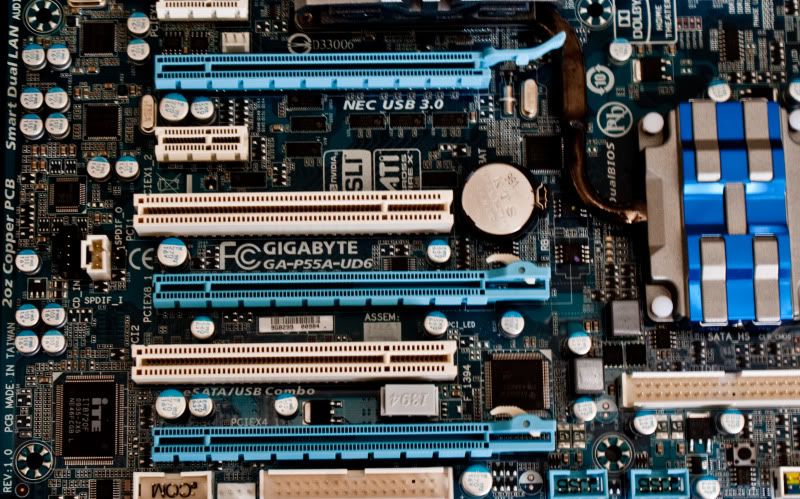
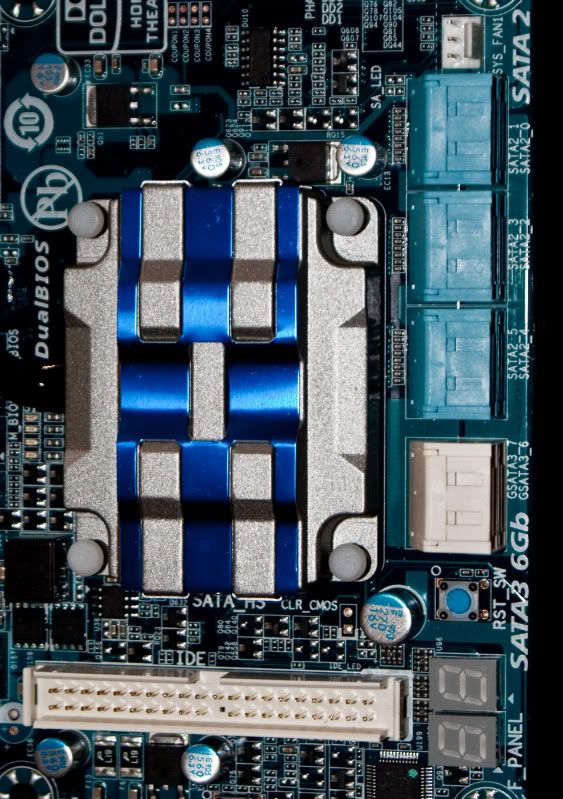
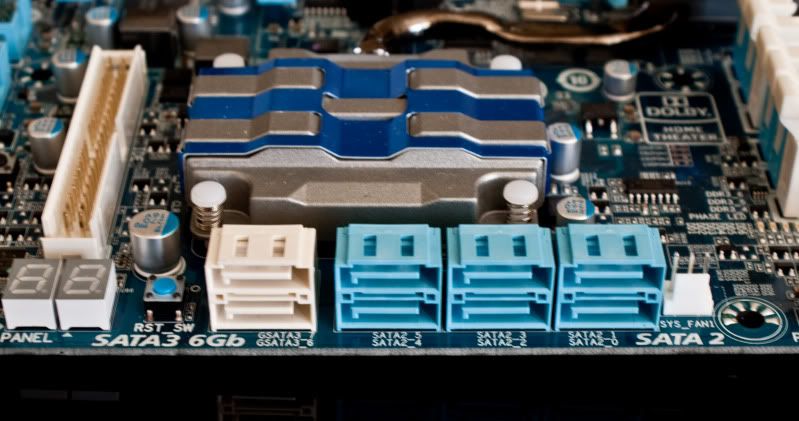
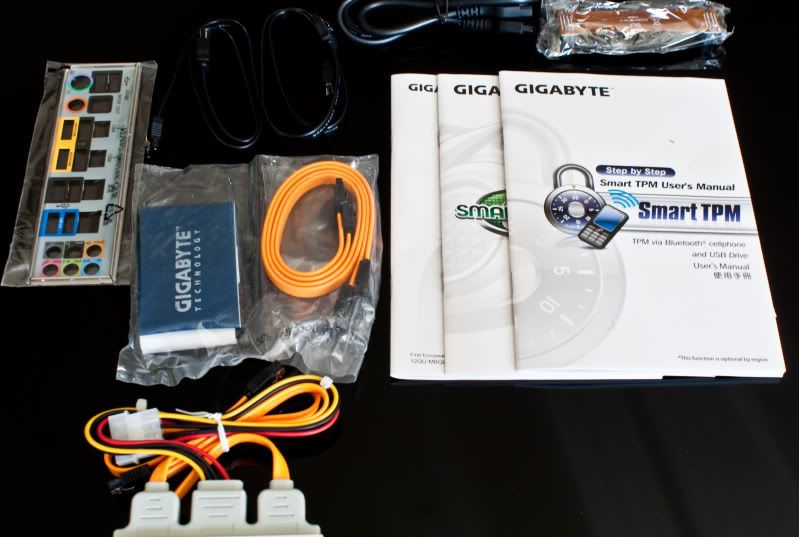











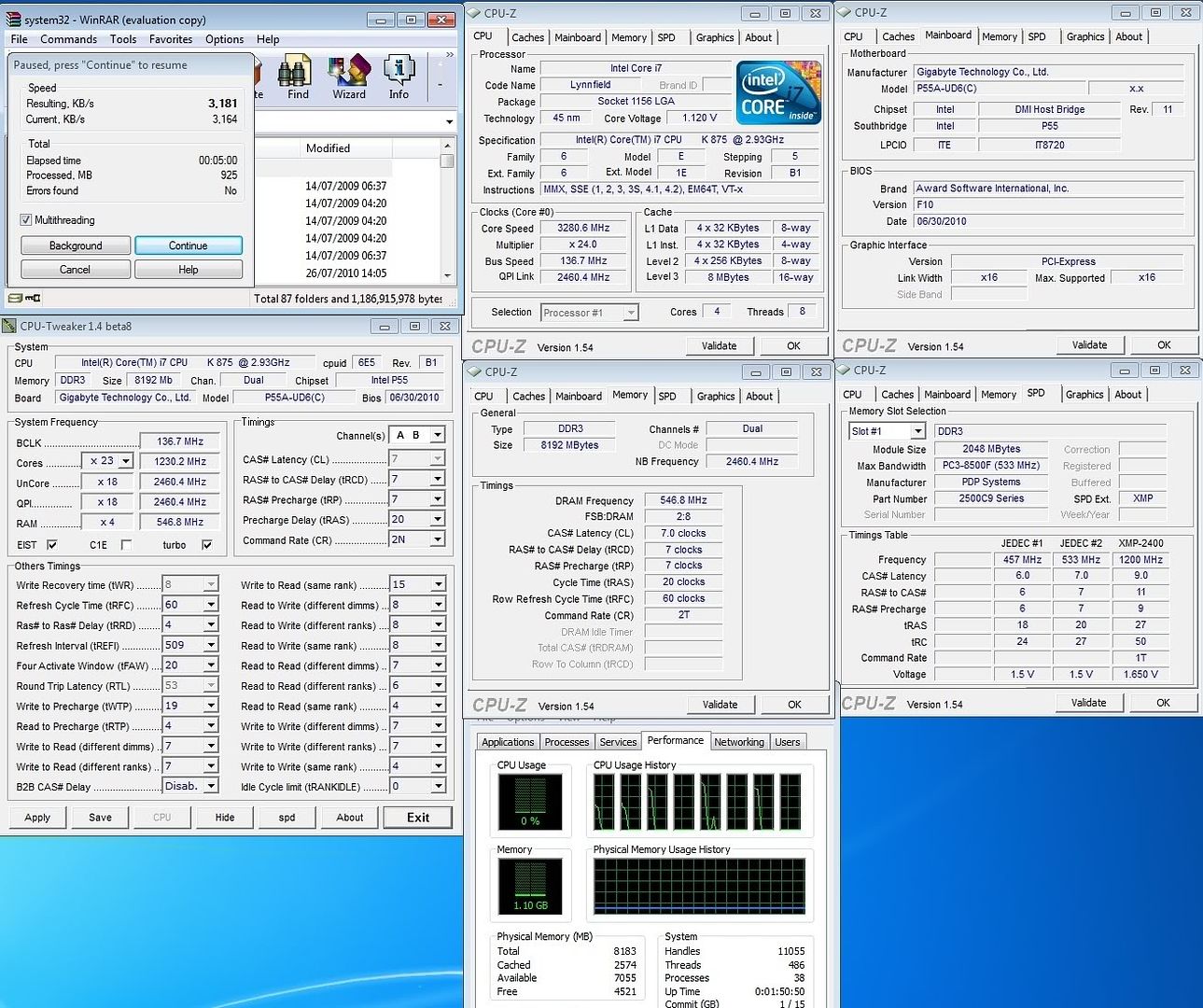












































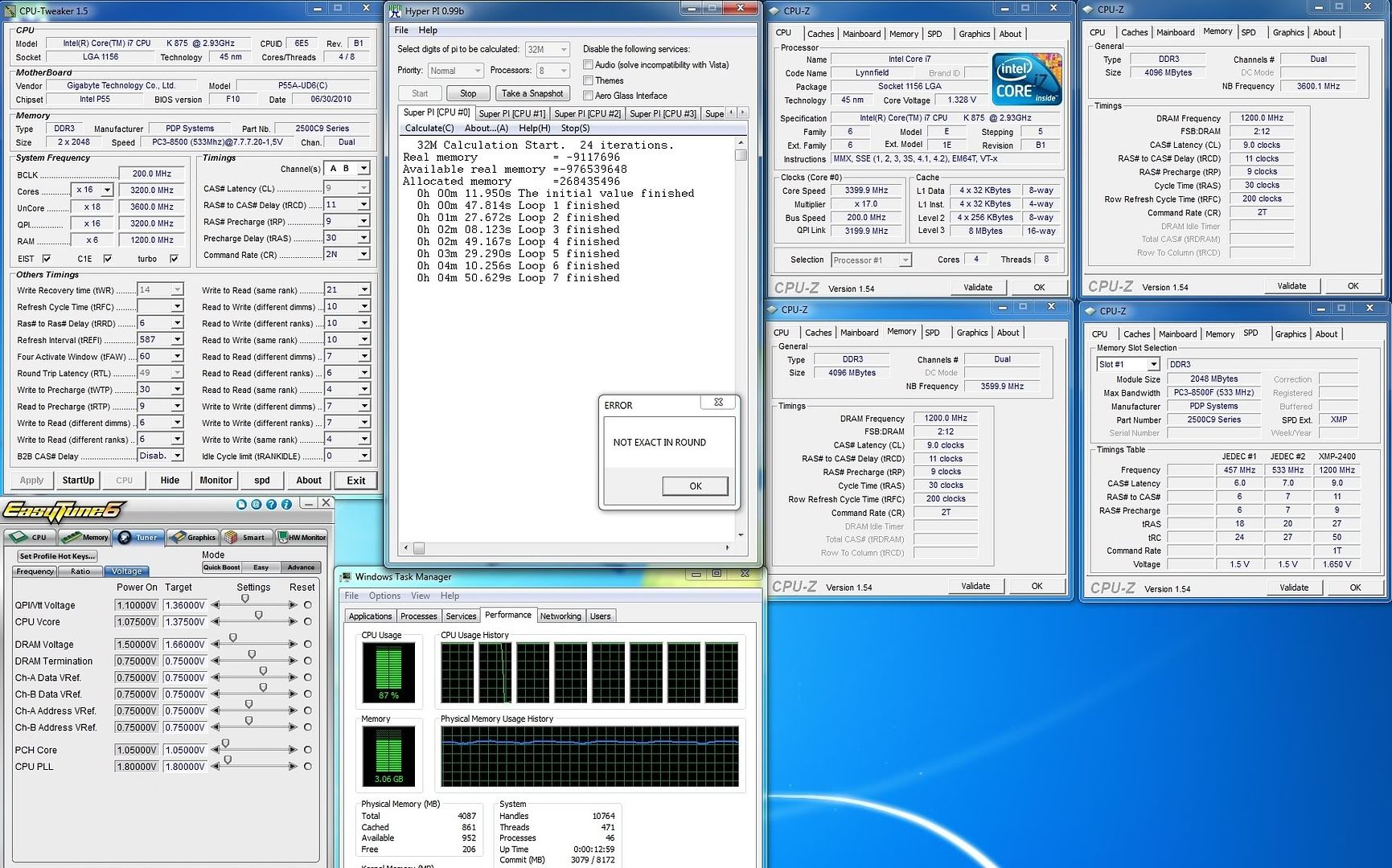
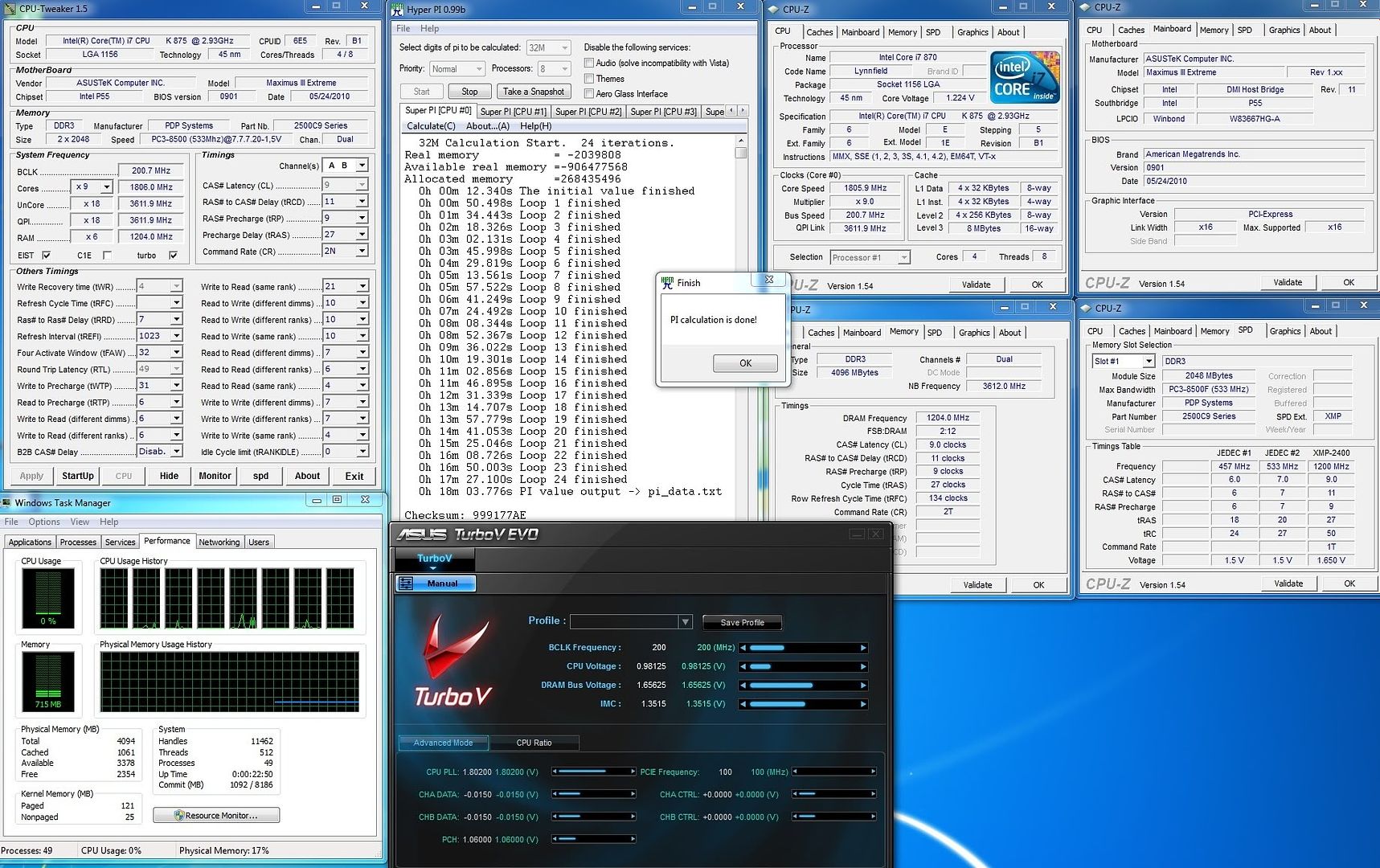
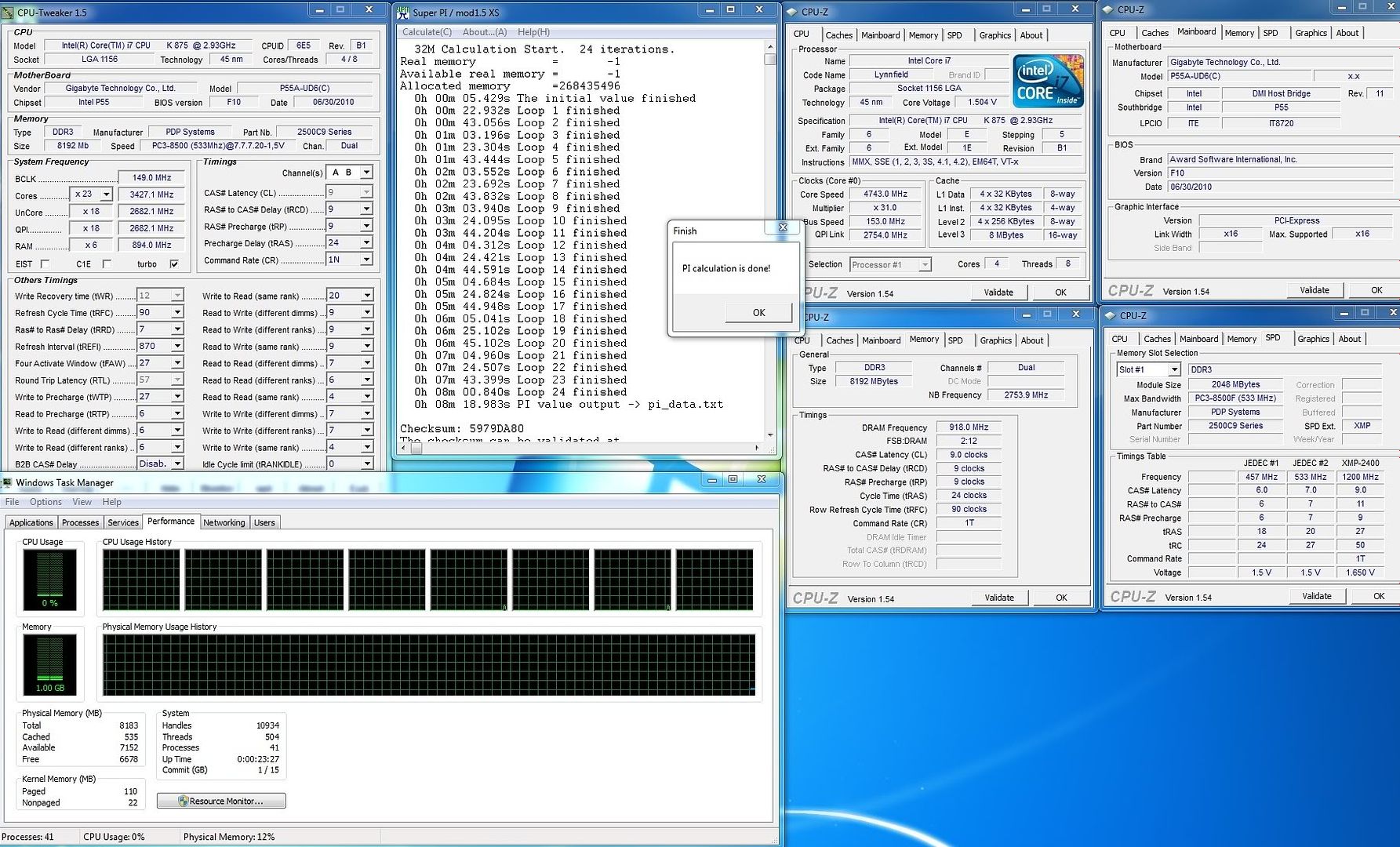
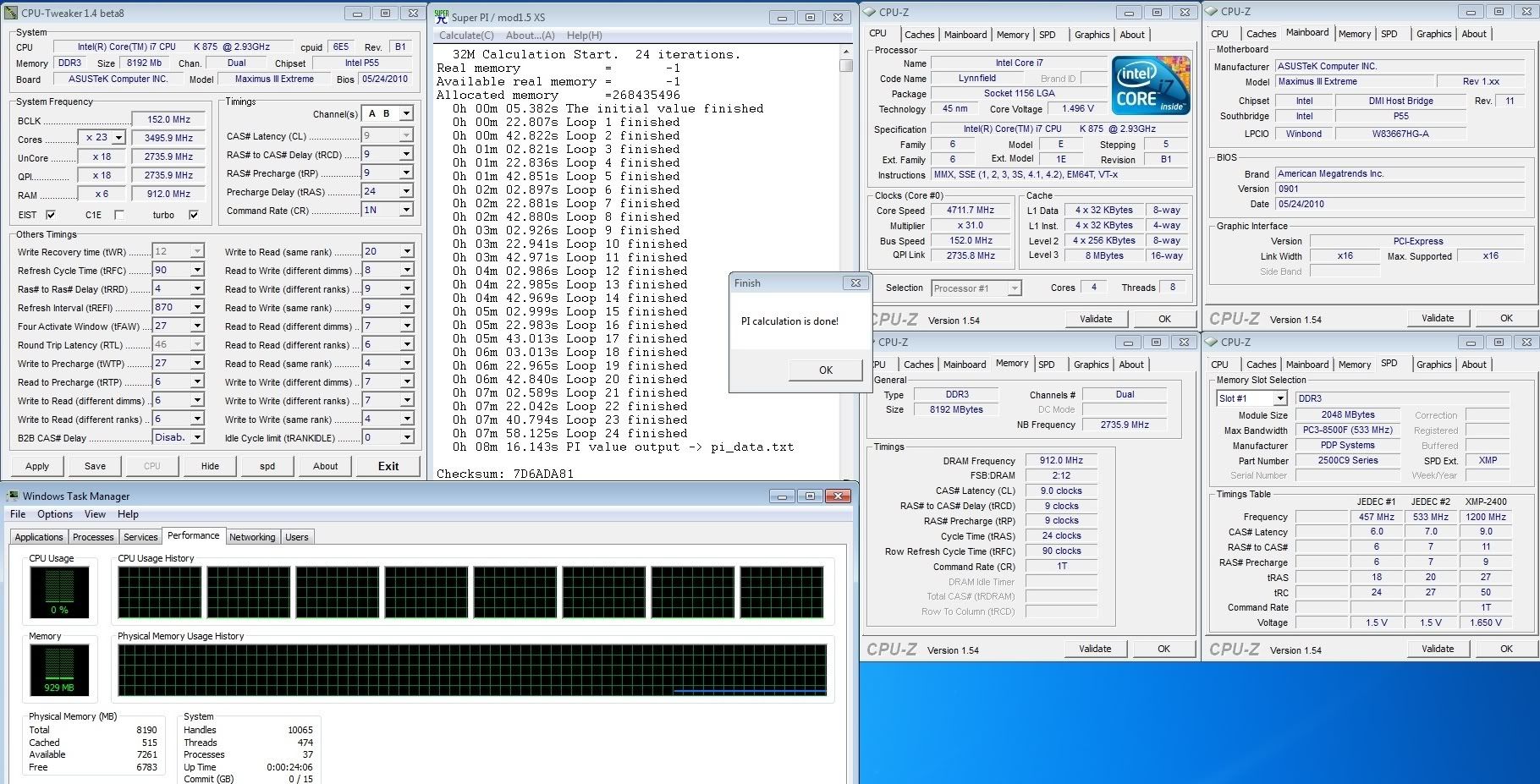
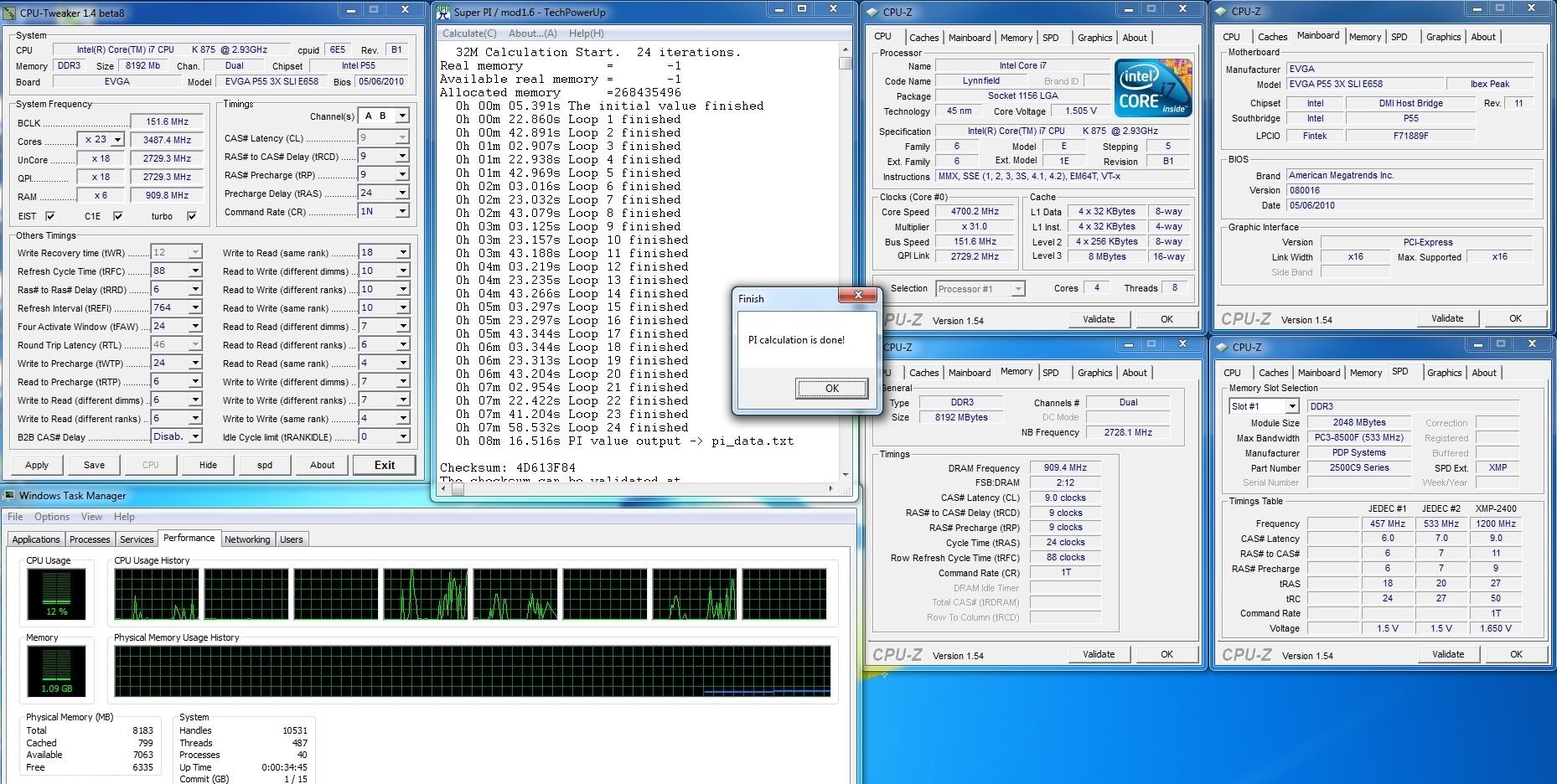
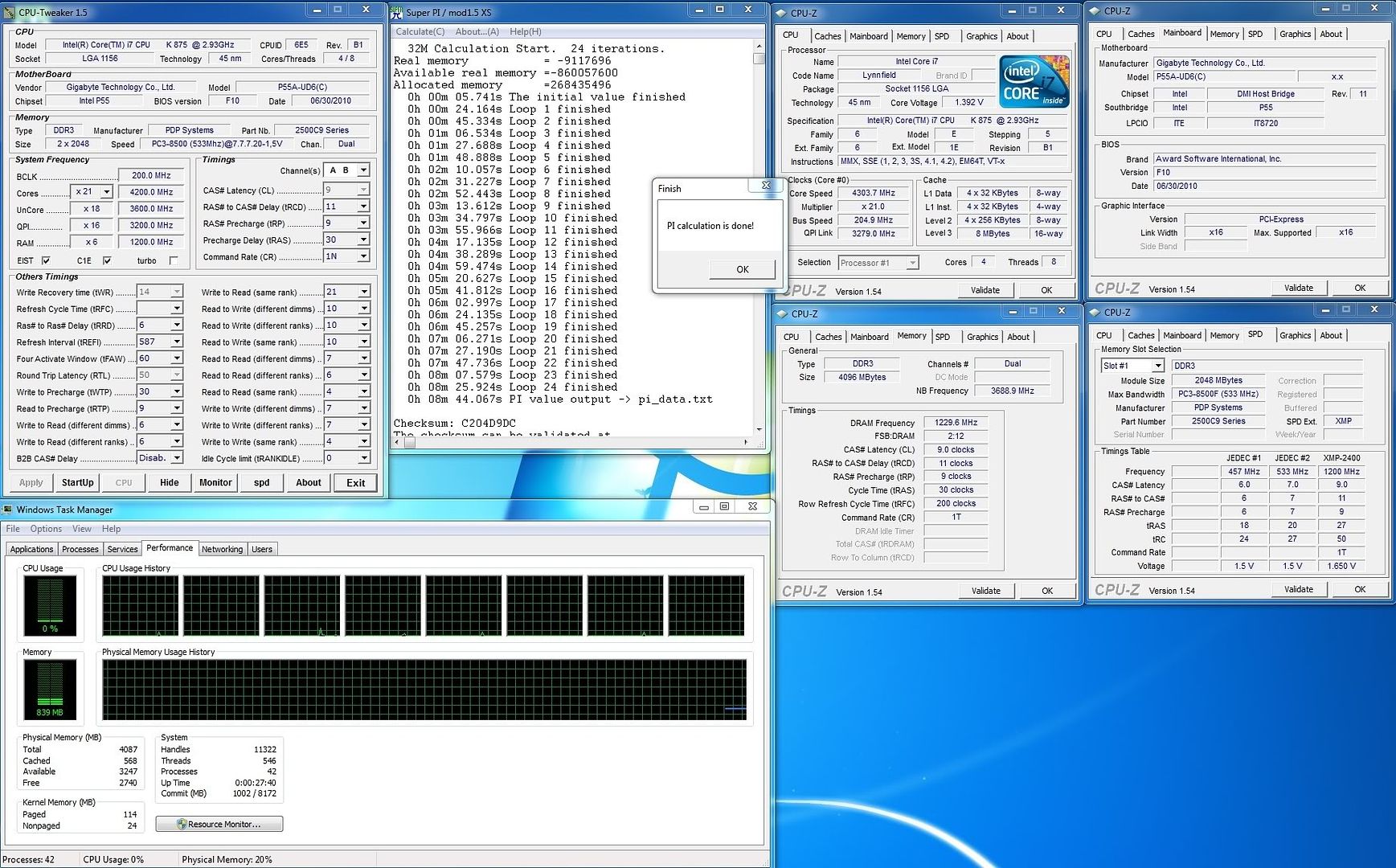
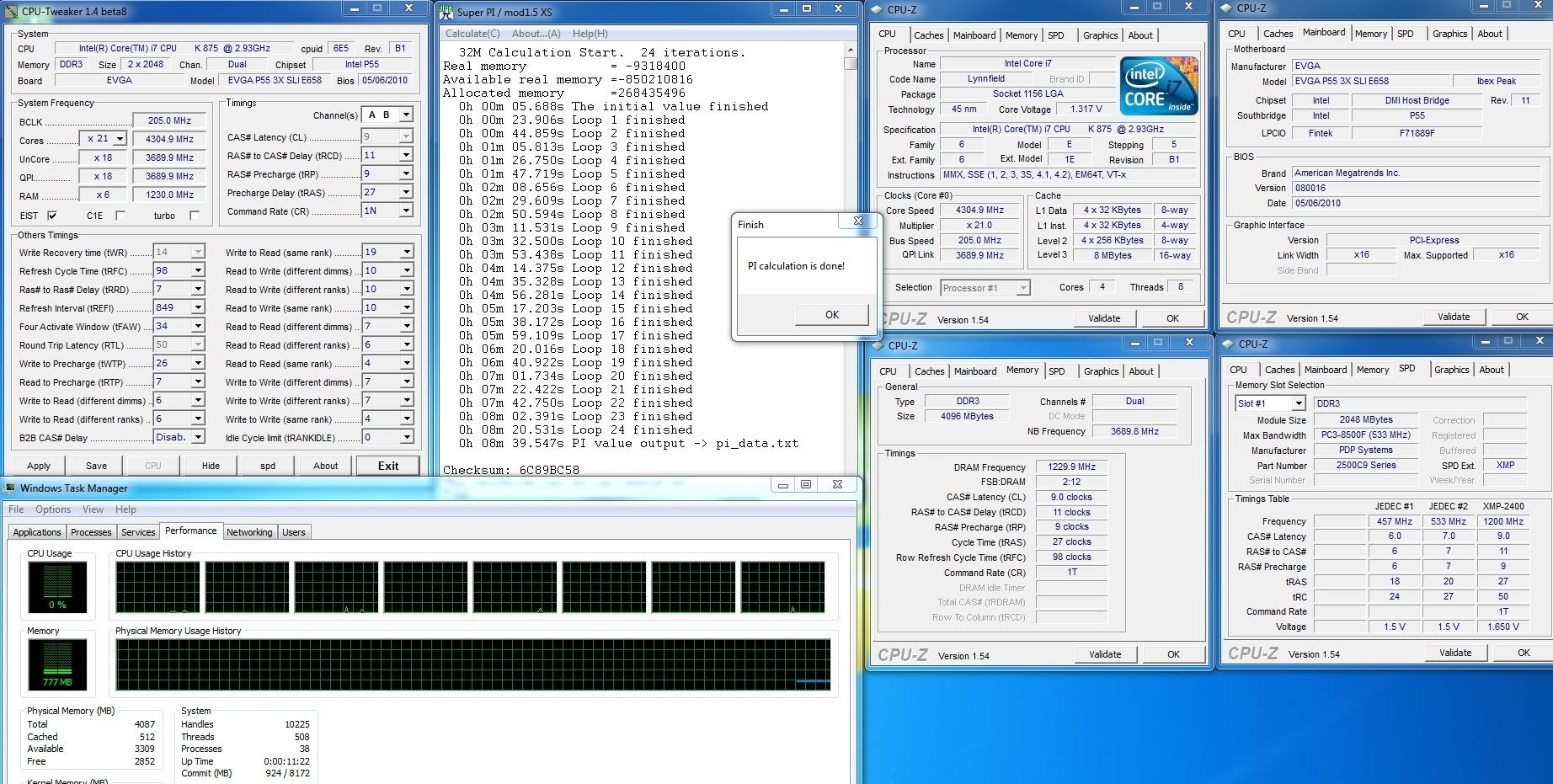
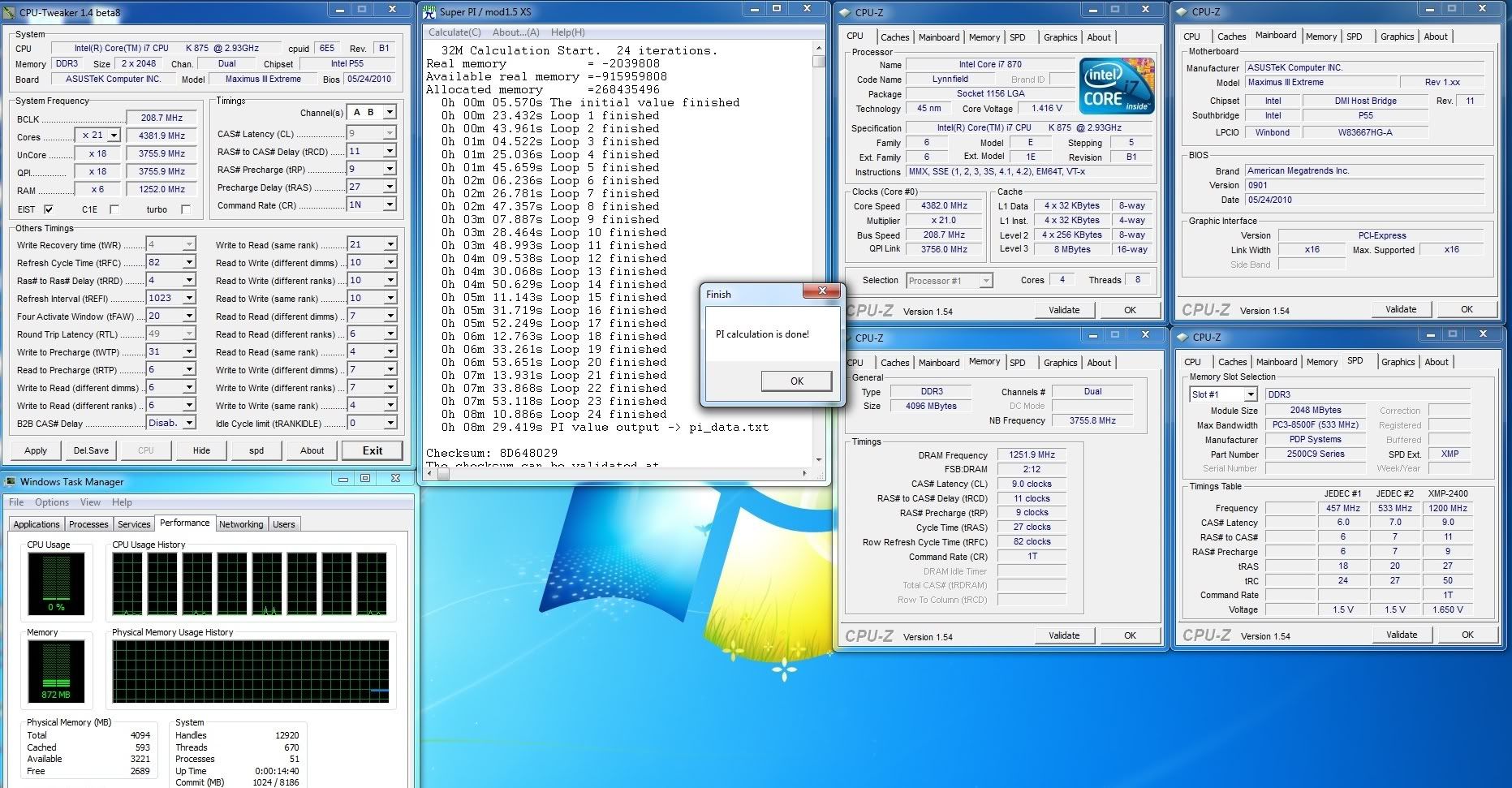
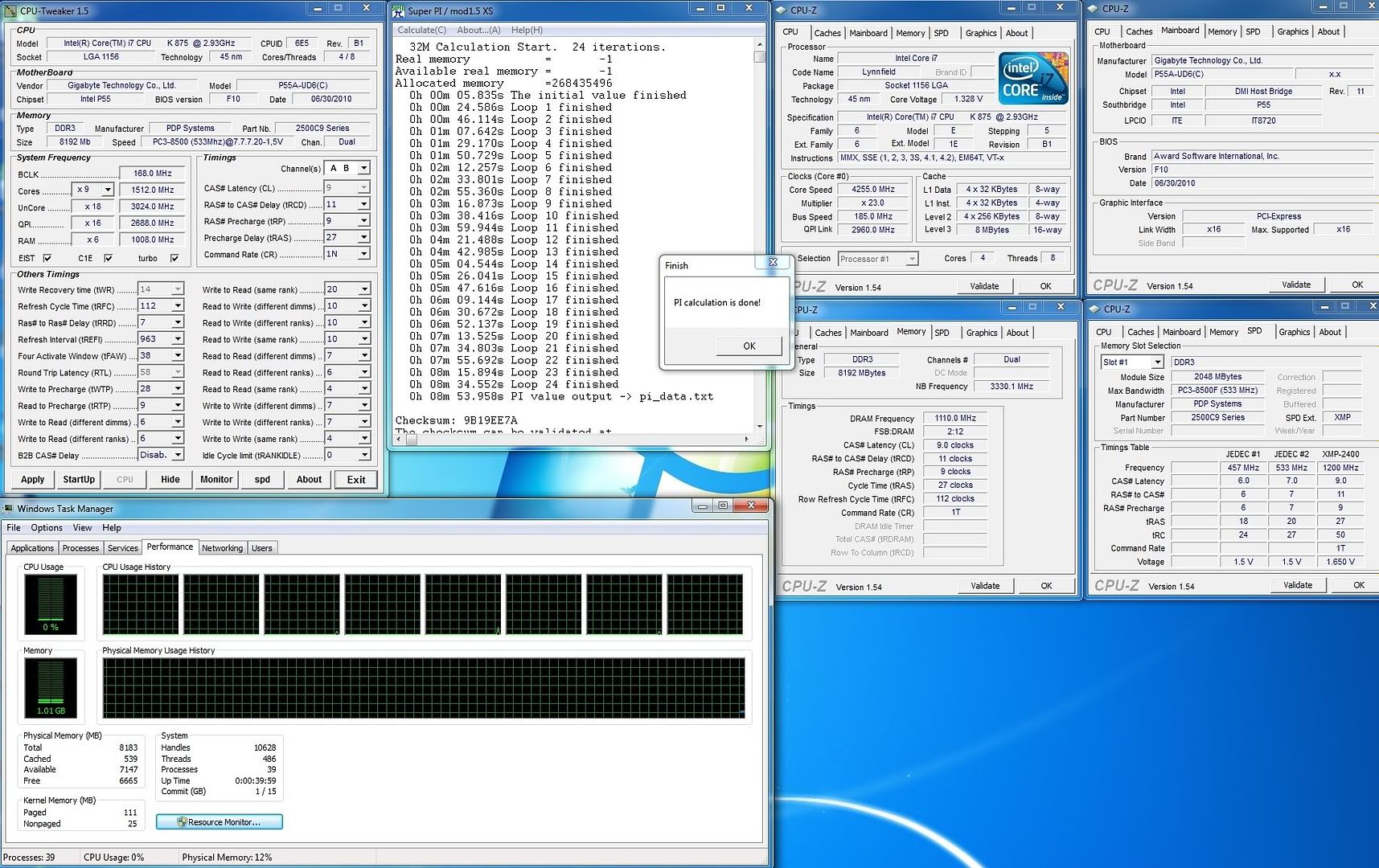
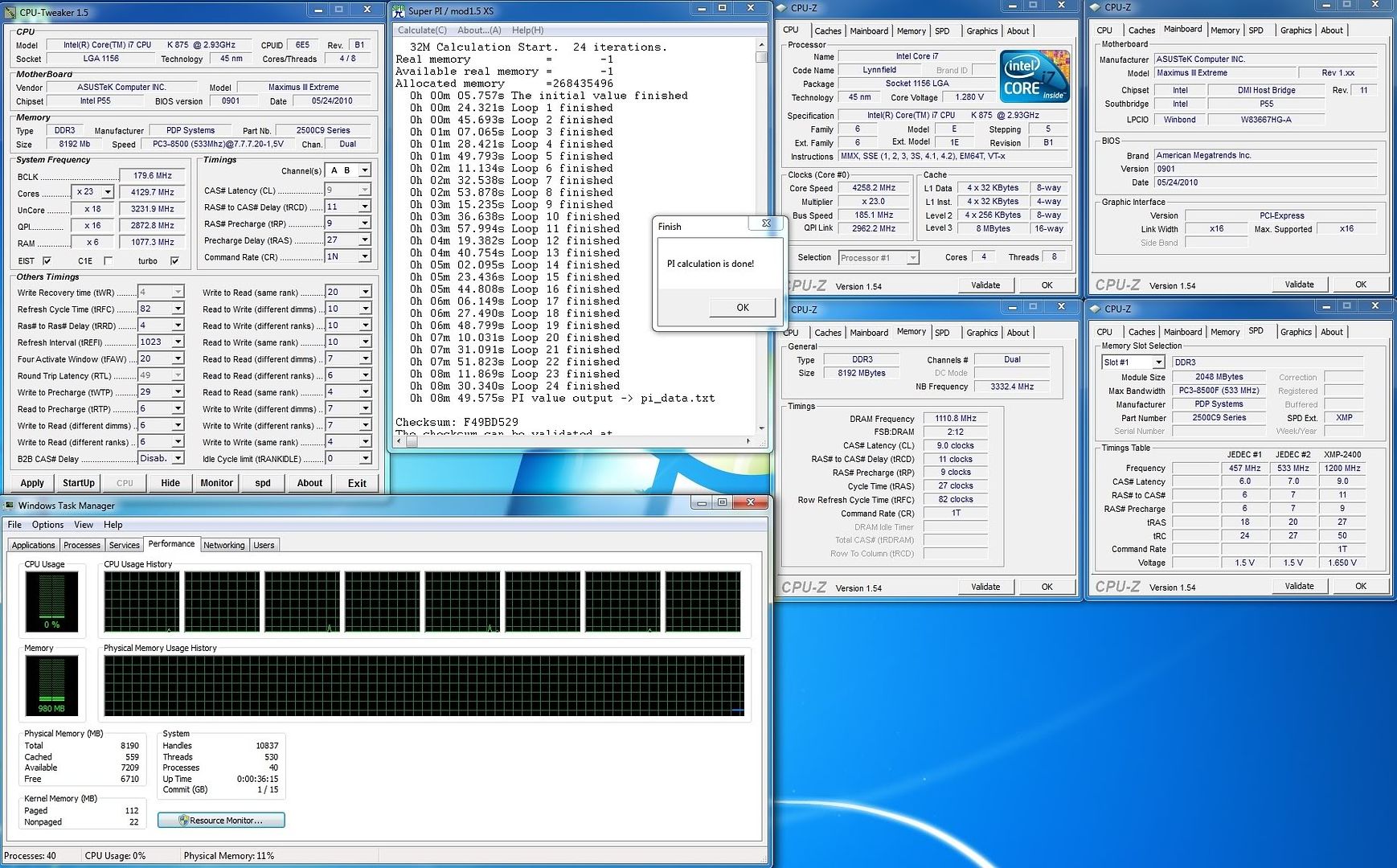

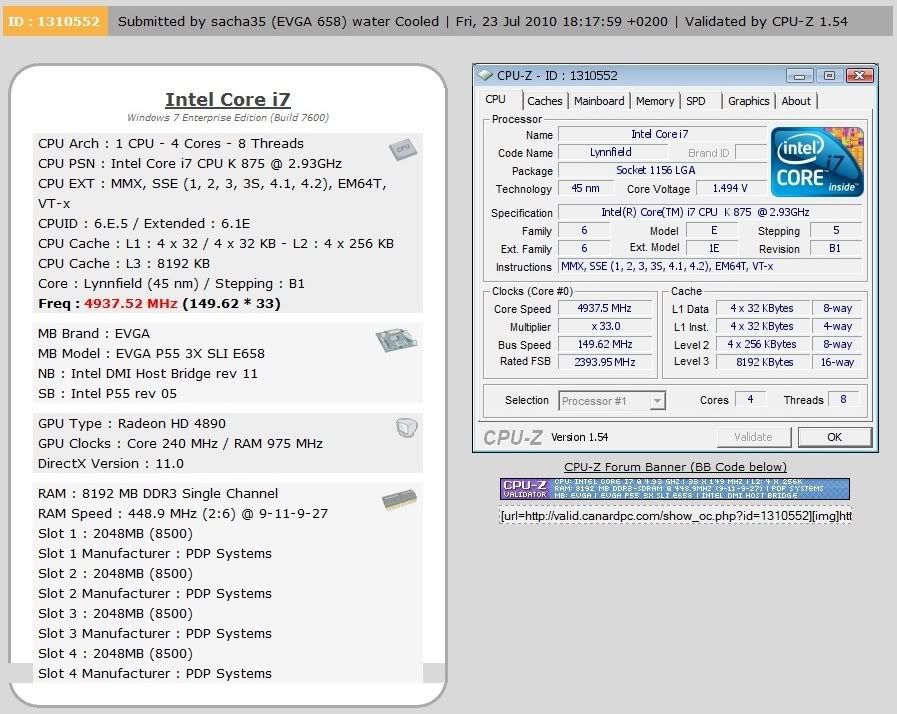
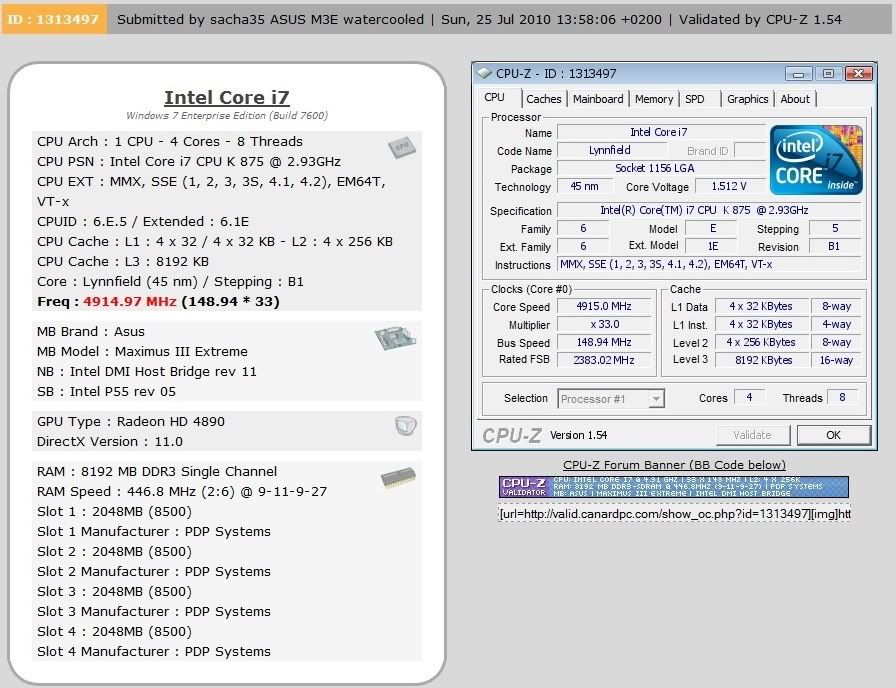

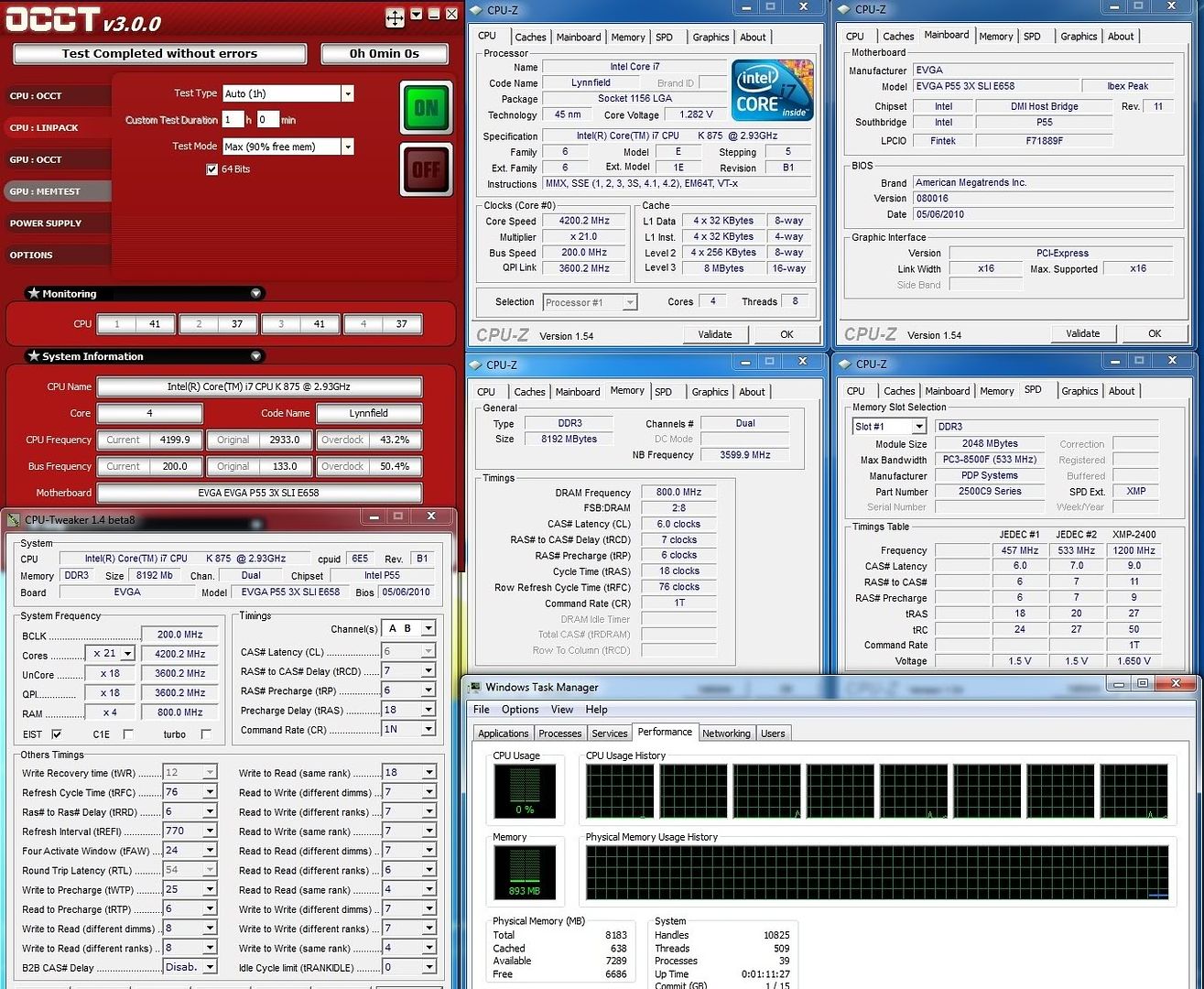
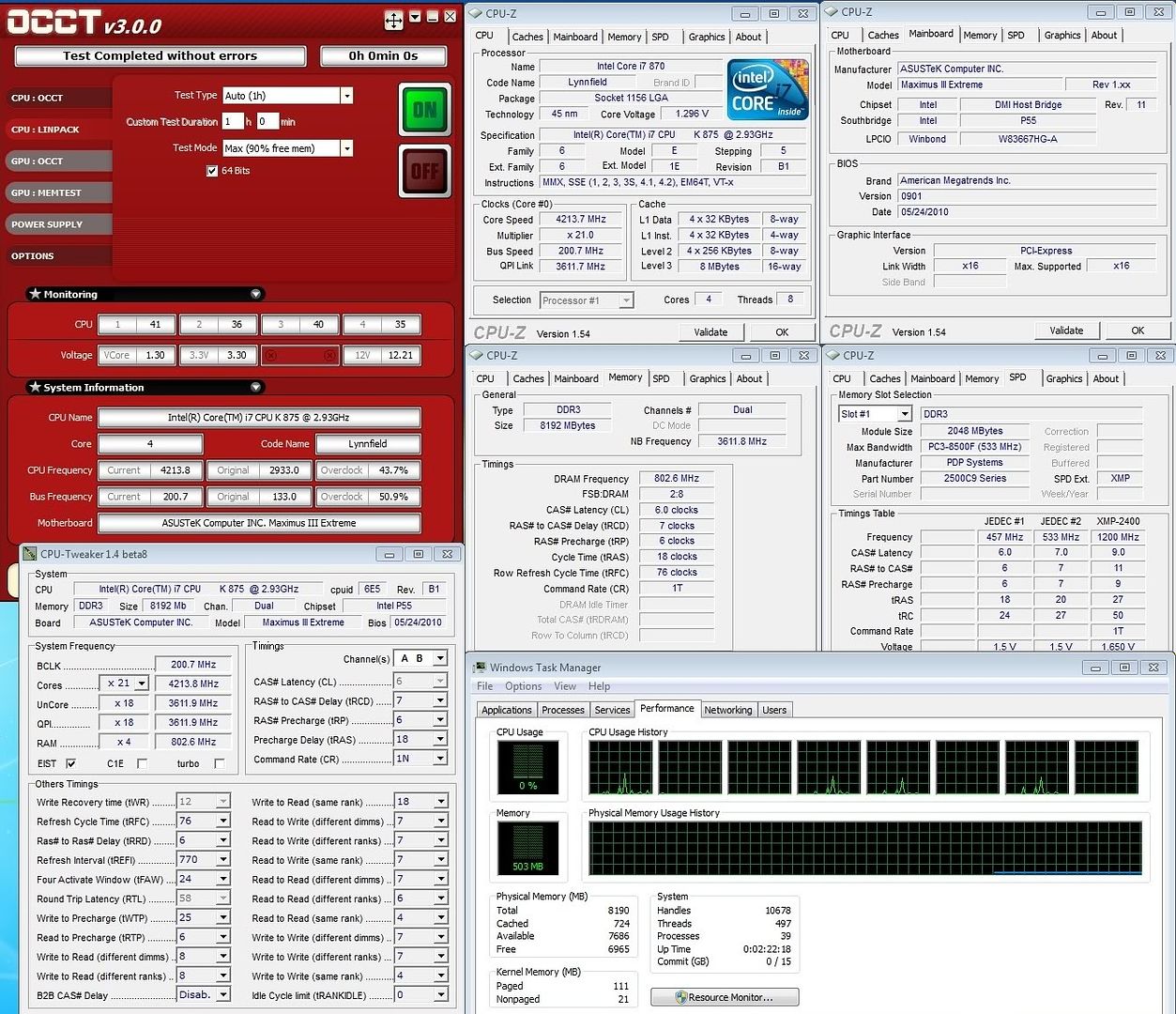


 Reply With Quote
Reply With Quote




 . Thanks for that
. Thanks for that  . I'd go with the M3E any day
. I'd go with the M3E any day 









Bookmarks